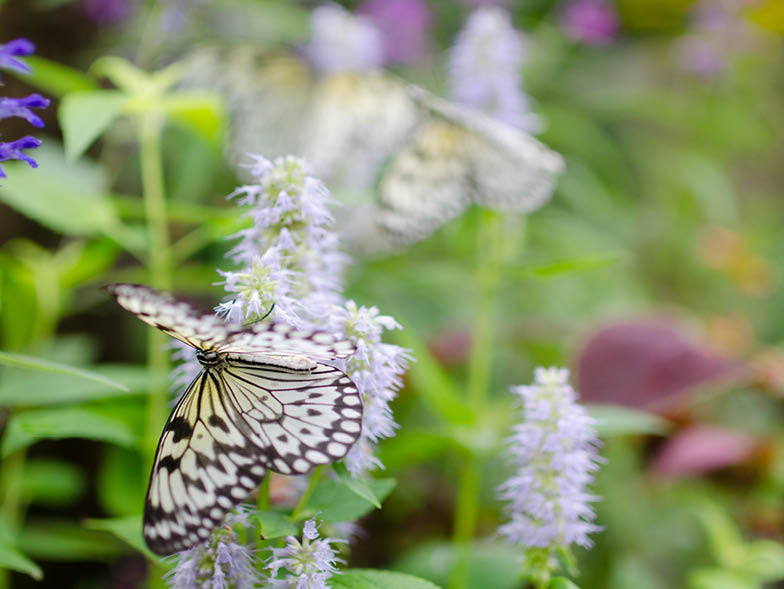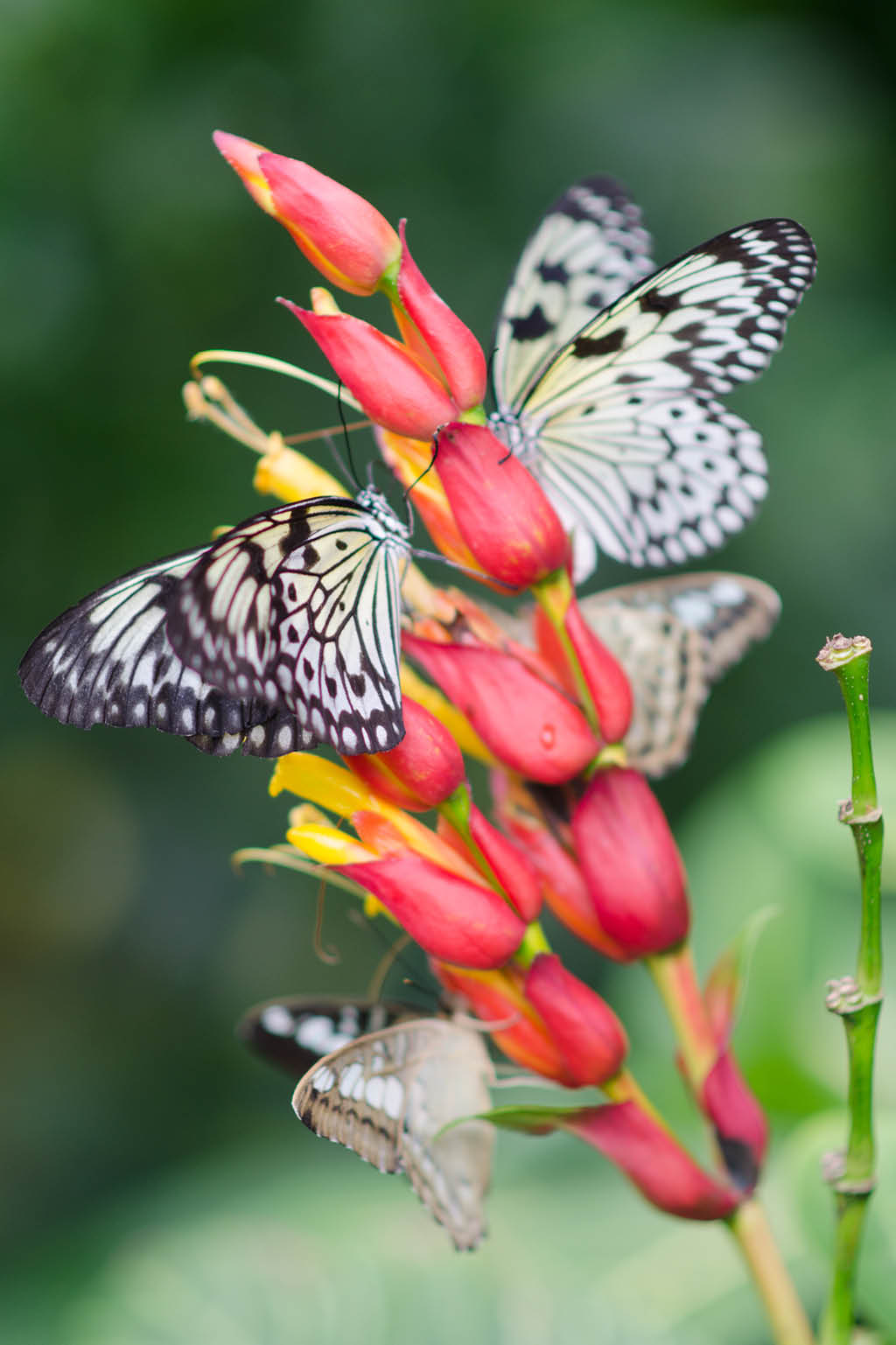Green Things and Butterfly Wings
The Florida Museum of Natural History’s Butterfly Rainforest Exhibit in Gainesville, Florida, has wooed many a visitor. We talked to Paul Ramey, assistant director of marketing and public relations.
What is a butterfly?
A butterfly is a type of insect. Insects are distinguished from all other animals by having an external skeleton (a hard outer covering), three main body parts (head, thorax, and abdomen), and three pairs of jointed legs (all attached to the thorax). Butterflies belong to the order of insects called Lepidoptera, which means “scaled wings.”
What are the stages of a butterfly’s life cycle?
The life cycle of a butterfly involves four stages: the egg, the larva or caterpillar, the pupa or chrysalis, and the adult. A butterfly starts as an egg. After about four to five days (some species take up to three weeks or longer), the egg hatches, and a tiny larva (caterpillar) emerges. The larva starts to eat and will shed its skin four to six times as it grows. After about two to four weeks, the larva will be full grown and transform itself into a pupa/chrysalis. Inside the pupa, the caterpillar’s body breaks down into a kind of soup and is reorganized into the adult structures of the butterfly! This stage can take between ten to fifteen days. Finally, the adult butterfly emerges from the pupa. Adult butterflies will mate, the female will lay eggs, and the life cycle starts over. The whole process is called metamorphosis, which means “change of form.”

What are the stages of a butterfly’s life cycle?
The life cycle of a butterfly involves four stages: the egg, the larva or caterpillar, the pupa or chrysalis, and the adult. A butterfly starts as an egg. After about four to five days (some species take up to three weeks or longer), the egg hatches, and a tiny larva (caterpillar) emerges. The larva starts to eat and will shed its skin four to six times as it grows. After about two to four weeks, the larva will be full grown and transform itself into a pupa/chrysalis. Inside the pupa, the caterpillar’s body breaks down into a kind of soup and is reorganized into the adult structures of the butterfly! This stage can take between ten to fifteen days. Finally, the adult butterfly emerges from the pupa. Adult butterflies will mate, the female will lay eggs, and the life cycle starts over. The whole process is called metamorphosis, which means “change of form.”
How often do butterflies mate and lay eggs?
Typically once. They emerge, mate, lay their eggs, and die.
What are the major differences between moths and butterflies? Do you have both in the exhibit?
The most easily recognizable difference is the antennae. While there are some exceptions, moths typically have shorter, feathered antennae, and butterflies have long, slender antennae. Moths also are typically active at night and butterflies during the day. We primarily display butterflies in the Rainforest exhibit, though at times we may place a male Atlas moth on a tree in the exhibit for visitors to observe. Because they are typically active at night, they will normally stay in that location until they are removed and taken back into the rearing lab for the night.
What do butterflies eat?
Most adult butterflies sip nectar from flowers through their proboscis, which acts like a straw. Some species vary their nectar diet to include rotting fruit, pollen, animal excrement, and carrion.
How do you prepare them for emerging?
A small dot of glue from a hot glue gun is placed on a sheet of paper, and the chrysalis is inserted into the wet glue at the silk end of the chrysalis (where it was originally hanging). After the glue dries and the sheet is filled, it is placed into a case in the rearing lab where visitors may observe the butterflies emerging. You can also watch this online through our webcam.

How many butterflies are in the Butterfly Rainforest?
At any time, approximately sixty to eighty species can be seen in the Butterfly Rainforest. The continuous population will be several hundred to over 1,000. Approximately 900 adult butterflies are added weekly.
How much do butterflies cost?
The price can vary widely depending on the supplier, quantity of order, species, time of year, etc., and ranges from seventy-five cents to three dollars or more.
Where do you get the butterflies?
The majority of the butterflies in the Rainforest are bred in butterfly farms throughout the world, primarily Malaysia, the Philippines, Costa Rica, Suriname, El Salvador, Ecuador, Australia, New Guinea, Madagascar, Africa, and Florida. They are shipped to us in the pupal stage and emerge as adult butterflies in our rearing lab. We periodically rear some species of butterflies, primarily for larval display, but not with the intent to increase the adult population in the Rainforest. The rearing lab allows our guests a closer look at the life cycle of the butterfly, from egg to larva to pupa to adult. Visitors have the chance to see voracious caterpillars feeding on their host plants. They can also view the variety of pupae before they emerge as adult butterflies.
Are the species all kept separate until they are released into the exhibit?
No. They are grouped together when glued to the sheets of paper, but there may be many species together in the same case. After they emerge and are ready to fly, they are placed together in the same screen boxes used to take them into the exhibit and are released.
How often do you release new species into the exhibit?
Every day unless it’s extremely cold or expected to freeze that night. Weather permitting, we have scheduled releases for visitors every day at 2:00 p.m. with additional releases at 3:00 p.m. and 4:00 p.m. on weekends.
When is the best time to see the butterflies?
Anytime the temperature is 65°F or warmer, and it’s sunny. The most comfortable times for visitors are fall and spring, when it’s not as hot, but the butterflies are active in hot weather. There is always more butterfly activity when it’s sunny, regardless of the temperature.

Are butterflies important?
Yes! They are important pollinators of flowering plants, much like bees. Butterflies are also very sensitive to changes in the environment and are widely used by ecologists to help evaluate the impacts of habitat loss, pesticides, and climate change.
How old is the exhibit?
The Butterfly Rainforest opened August 14, 2004—the day Hurricane Charley was forecast to come through Gainesville. We were spared when it went across the center of the state, through Orlando.
What are the goals of the exhibit?
The Butterfly Rainforest is the public side of the museum’s McGuire Center for Lepidoptera and Biodiversity, the world’s largest research facility for the study of butterflies and moths. We seek to educate visitors about Lepidoptera biology, butterflies’ importance as pollinators, and the essential environmental preservation aspect of supporting butterfly farming in other countries. We also strive to provide a rewarding experience with hundreds of free-flying butterflies; viewing these delicate creatures together can create an extremely amazing, peaceful, or gratifying moment. Many visitors have described their first visit upon entering the exhibit as a “Disney” moment, which means it’s extremely special—something that cannot be experienced anywhere else. Besides their beauty and grace, butterflies are also considered symbols of hope and life, and that is an important component for some visitors. For example, we work with University of Florida Health to allow cancer patients and their families in town for treatment to visit the Rainforest. The exhibit also provides an opportunity for visitors to observe exotic butterflies from other countries they may not have an opportunity to see anywhere else.
For more info, visit flmnh.ufl.edu.






















